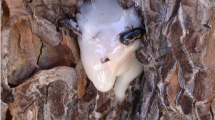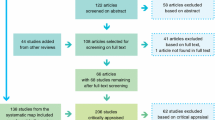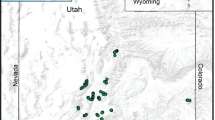Abstract
Disturbances like biological invasions and fire may affect in unexpected ways plant-animal interactions. In northwestern Patagonia, introduced ungulates (cattle, horses and deers) are widespread and very common occupying more than 50% of forests and shrublands, widely affecting these habitats. In addition, fire play a major role in creating landscape patterns in this region. We evaluated whether fire modify the impacts of introduced ungulates on plant-animal interactions. In a mature forest (unburnt) and in an early post-fire area (burnt) we used structural equation modeling (SEM) to analyzed the impacts of introduced ungulates on insect herbivory, pollination and pre-dispersal seed predation on Berberis darwinii, one of the most common understory shrub of temperate forests. We found that the effects of cattle on pollination and fruit set depended on the habitat condition (i.e. unburnt or burnt). Introduced ungulates in unburnt forest decreased fruit set through a reduction on pollinator visits. Conversely, introduced ungulates in burnt forest increased pollinator visits and flower production without affecting fruit set. On the other hand, damage patterns (herbivory and fruit/seed predation) were unaffected by cattle in both forests types. Either, low browsing pressure or induction of plant defences may explain our results. This study illustrates how modifications on biotic and abiotic conditions produced by fire may affect in complex ways the effect of introduced ungulates on plant-animal interactions.


Similar content being viewed by others
References
Administración de Parques Nacionales (1999) Informe sobre las consecuencias ecológicas de los incendios forestales. Temporada 1998–1999. Parque Nacional Nahuel Huapi, San Carlos de Bariloche, Argentina
Aizen MA, Feisinger P (2003) Bees not to be? Responses of insect pollinator faunas and flower pollination to habitat fragmentation. In: Bradshaw GA, Marquet PA (eds) How landscapes change: human disturbance and ecosystem fragmentation in the Americas. Springer, Berlin, pp 111–129
Allen RB (1991) A preliminary assessment of the establishment and persistence of Berberis darwinii Hook., a naturalised shrub in secondary vegetation near Dunedin. NZ J Bot 29:353–360
Barros V, Cordón V, Moyano C, et al. (1983) Cartas de precipitación de la Zona Oeste de las Provincias de Río Negro y Neuquén. Internal report. Facultad de Ciencias Agrarias. Universidad Nacional del Comahue, Neuquén, Argentina
Belsky AJ (1986) Does herbivory benefit plants? A review of the evidence. Am Nat 127:870–892
Blackhall M, Raffaele E, Veblen TT (2008) Cattle affect early post-fire regeneration in a Nothofagus dombeyi–Austrocedrus chilensis mixed forest in northern Patagonia, Argentina. Biol Conserv 141:2251–2261
Bolker B, Holyoak M, Krivan V et al (2003) Connecting theoretical and empirical studies of trait-mediated interactions. Ecology 84:1101–1114
Bollen KA, Stine RA (1992) Bootstrapping goodness-of-fit measures in structural equation models. Soc Methods Res 21:205–229
Brion C, Puntieri J, Grigera D et al (1988) Flora de Puerto Blest y sus alrededores. Universidad Nacional del Comahue, General Roca
Byers JE (2002) Impact of non-indigenous species enhanced by anthropogenic alteration of selection regimes. Oikos 97:449–458
Cabrera AL (1994) Regiones Fitogeográficas Argentinas. Editorial Acme S.A.C.I.C, Buenos Aires
Campbell JW, Hanula JL, Waldrop TA (2007) Effects of prescribed fire and fire surrogates on floral visiting insects of the blue ridge province in North Carolina. Biol Conserv 134:393–404
Chamberlain SA, Bronstein JL, Rudgers JA (2014) How context dependent are species interactions? Ecol Lett 17:881–890
Cohen D, Shmida A (1993) The evolution of flower display and reward. In: Hecht MK, MacIntyre RJ, Clegg MT (eds) Evol Biol. Springer, Boston, pp 197–243
Correa MN (1988) Flora Patagonica (Republica Argentina). Colección Científica del I.N.T.A, Capital Federal
D’Antonio CM, Tunison JT, Loh RK (2000) Variation in the impact of exotic grasses on native plant composition in relation to fire across an elevation gradient in Hawaii. Austral Ecol 25:507–522
de Paz M, Raffaele E (2013) Cattle change plant reproductive phenology, promoting community changes in a post-fire Nothofagus forest in northern Patagonia, Argentina. J Plant Ecol 6:459–467
De Pietri DE (1992) The search for ecological indicators: is it possible to biomonitor forest system degradation caused by cattle ranching activities in Argentina? Vegetatio 101:109–121
Didham RK, Tylianakis JM, Gemmell NJ et al (2007) Interactive effects of habitat modification and species invasion on native species decline. Trends Ecol Evol 22:489–496
Dirzo R, Domínguez CA (1995) Plant-herbivore interactions in Mesoamerican tropical dry forests. In: Bullock SH, Medina E, Mooney HA (eds) Seasonally dry tropical forests. Cambridge University Press, Cambridge, pp 304–325
Fisher BL (1998) Insect behavior and ecology in conservation: preserving functional species interactions. Ann Entomol Soc Am 91:155–158
Freeman RS, Brody AK, Neefus CD (2003) Flowering phenology and compensation for herbivory in Ipomopsis aggregata. Oecologia 136:394–401
Gómez JM, González-Megías A (2002) Asymmetrical interactions between ungulates and phytophagous insects: size difference matters. Ecology 83:203–211
Gómez JM, González-Megías A (2007) Long-term effects of ungulates on phytophagous insects. Ecol Entomol 32:229–234
Gómez JM, Valladares F, Puerta-Piñero C (2004) Differences between structural and functional environmental heterogeneity caused by seed dispersal. Funct Ecol 18:787–792
Grace JB (2006) Structural equation modeling and natural systems. Cambridge University Press, Cambridge
Hamer KC, Hill JK, Benedick S et al (2003) Ecology of butterflies in natural and selectively logged forests of northern Borneo: the importance of habitat heterogeneity. J Appl Ecol 40:150–162
Herrera CM (1984) Selective pressures on fruit seediness: differential predation of fly larvae on the fruits of Berberis hispanica. Oikos 42:166–170
Hobbs NT (1996) Modification of ecosystems by ungulates. J Wildl Manage 60:695–713
Huntly N (1991) Herbivores and the dynamics of communities and ecosystems. Annu Rev Ecol Syst 22:477–503
Iranzo EC, Traba J, Acebes P et al (2013) Niche segregation between wild and domestic herbivores in Chilean Patagonia. PLoS ONE 8:e59326
Jaksic FM (1998) Vertebrate invaders and their ecological impacts in Chile. Biodivers Conserv 7:1427–1445
Jaksic FM, Iriarte JA, Jiménez JE et al (2002) Invaders without frontiers: cross-border invasions of exotic mammals. Biol Invasions 4:157–173
Juenger T, Bergelson J (1998) Pairwise versus diffuse natural selection and the multiple herbivores of Scarlet Gilia, Ipomopsis aggregata. Evolution 52:1583–1592
Kearns CA, Inouye DW (1997) Pollinators, flowering plants, and conservation biology. Bioscience 47:297–307
Kearns CA, Inouye DW, Waser NM (1998) Endangered mutualismas: the conservation of plant-pollinator interactions. Annu Rev Ecol Syst 29:83–112
Kestrup A, Ricciardi A (2009) Environmental heterogeneity limits the local dominance of an invasive freshwater crustacean. Biol Invasions 11:2095–2105
Kitzberger T, Veblen TT (1999) Fire-induce changes in northern Patagonian landscapes. Landscape Ecol 14:1–15
Lehtilä K, Strauss SY (1997) Leaf damage by herbivores affects attractiveness to pollinators in wild radish, Raphanus aphanistrum. Oecologia 111:396–403
Martín C, Mermoz M, Gallopin G (1985) Impacto de la ganaderia en la cuenca del Río Manso superior. Parte 1. Bosque de ñire con Laura. Reporte Administración de Parques Nacionales, Buenos Aires
McNaughton SJ (1983) Compensatory plant growth as a response to herbivory. Oikos 40:329–336
Merino ML, Carpetti BN, Abba AM (2009) Invasive mammals in the National Parks system of Argentina. Nat Areas J 29:42–49
Mermoz M, Kitzberger T, Veblen TT (2005) Landscape influences on occurrence and spread of wildfires in Patagonia forest and shrublands. Ecology 86:2705–2715
Mitchell RJ (2001) Path analysis: Pollination. In: Scheiner SM, Gurevitch J (eds) Design and analysis of ecological experiments. Oxford University Press, Oxford, pp 211–231
Morales CL, Aizen MA (2002) Does invasion of exotic plants promote invasion of exotic flower visitors? A case study from temperate forests of the southern Andes. Biol Invasions 4:87–100
Mothershead K, Marquis RJ (2000) Fitness impacts of herbivory through indirect effects on plant–pollinator interactions in Oenothera macrocarpa. Ecology 81:30–40
Navas JR (1987) Los vertebrados exóticos introducidos en la Argentina. Revista del Museo Argentino de Ciencias Naturales ‘Bernardino Rivadavia’. Zoología 14:7–38
Ne’eman G, Dafni A, Potts SG (2000) The effect of fire on flower visitation rate and fruit set in four core-species in east Mediterranean scrubland. Plant Ecol 146:97–104
Nuñez MA, Relva MA, Simberloff D (2008) Enemy release or invasional meltdown? The role of exotic herbivores in pine invasion on Isla Victoria, Argentina. Austral Ecol 33:317–323
Nuñez MA, Bailey J, Schweitzer J (2010) Population, community and ecosystem effects of exotic herbivores: a growing global concern. Biol Invasions 12:297–301
Nuñez-Farfán J, Dirzo R (1991) Effects of defoliation on the samplings of a gap-colonizing neotropical tree. J Veg Sci 2:459–464
Paige KN, Whitham TG (1987) Overcompensation in response to mammalian herbivory: the advantage of being eaten. Am Nat 129:407–416
Paritsis J, Raffaele E, Veblen TT (2006) Vegetation disturbance by fire affects plant reproductive phenology in a shrubland community in northwestern Patagonia, Argentina. NZ J Ecol 30:387–395
Piazza M-V, Garibaldi LA, Kitzberger T et al (2016) Impact of introduced herbivores on understory vegetation along a regional moisture gradient in Patagonian beech forests. For Ecol Manag 366:11–22
Price PW (1991) The plant vigor hypothesis and herbivore attack. Oikos 62:244–251
R Development Core Team (2015) R: a language and environment for statistical computing. The R Foundation for Statistical Computing, Viena
Raffaele E, Veblen TT (2001) Effects of cattle grazing on early postfire regeneration of matorral in northwest Patagonia, Argentina. Nat Areas J 21:243–249
Raffaele E, Veblen TT, Blackhall M et al (2011) Synergistic influences of introduced herbivores and fire on vegetation change in northern Patagonia, Argentina. J Veg Sci 22:59–71
Randall JA, Walters MB (2011) Deer density effects on vegetation in aspen forest understories over site productivity and stand age gradients. For Ecol Manag 261:408–415
Relva MA, Veblen TT (1998) Impact of introduced large herbivores on Austrocedrus chilensis forest in northern Patagonia, Argentina. For Ecol Manag 108:27–40
Relva MA, Nuñez MA, Simberloff D (2010) Introduced deer reduce native plant cover and facilitate invasion of non-native tree species: evidence for invasional meltdown. Biol Invasions 12:303–311
Ricciardi A, Hoopes MF, Marchetti MP et al (2013) Progress toward understanding the ecological impacts of nonnative species. Ecol Monogr 83:263–282
Rodríguez-Auad K, Simonetti JA (2001) Evaluación de la folivoría: una comparación de dos métodos. Ecol Bolivia 36:65–69
Rodriguez-Cabal MA, Barrios-Garcia MN, Amico GC et al (2013) Node-by-node disassembly of a mutualistic interaction web driven by species introductions. Proc Natl Acad Sci 110:16503–16507
Rooney TP, Waller DM (2003) Direct and indirect effects of white-tailed deer in forest ecosystems. For Ecol Manag 181:165–176
Shimazaki A, Miyashita T (2002) Deer browsing reduces leaf damage by herbivorous insects through an induced response of the host plant. Ecol Res 17:527–533
Shipley B (2000) Cause and correlation in biology: a user’s guide to path analysis, structural equations and causal inference. Cambridge University Press, Cambridge
Simonetti JA, Grez AA, Celis-Diez JL et al (2007) Herbivory and seedling performance in a fragmented temperate forest of Chile. Acta Oecol 32:312–318
Smith DS, Lamit LJ, Lau MK et al (2015) Introduced elk alter traits of a native plant and its plant-associated arthropod community. Acta Oecol 67:8–16
Sokal RR, Rohlf FJ (1999) Introducción a la Bioestadística. Reverté Ediciones, Barcelona
Strauss SY, Conner JK, Rush SL (1996) Foliar herbivory affects floral characters and plant attractiveness to pollinators: implications for male and female plant fitness. Am Nat 147:1098–1107
Stritar M, Schweitzer J, Hart S et al (2010) Introduced ungulate herbivore alters soil processes after fire. Biol Invasions 12:313–324
Suarez ML, Kitzberger T (2010) Differential effects of climate variability on forest dynamics along a precipitation gradient in northern Patagonia. J Ecol 98:1023–1034
Tadey M (2015) Indirect effects of grazing intensity on pollinators and floral visitation. Ecol Entomol 40:451–460
Tercero-Bucardo N, Kitzberger T, Veblen TT et al (2007) A field experiment on climatic and herbivore impacts on post-fire tree regeneration in north-western Patagonia. J Ecol 95:771–779
Traveset A, Richardson DM (2006) Biological invasions as disruptors of plant reproductive mutualisms. Trends Ecol Evol 21:208–216
Tutiempo Network SL (2017) In: Madrid, España. https://www.tutiempo.net/
Valiente-Banuet A, Aizen MA, Alcántara JM et al (2015) Beyond species loss: the extinction of ecological interactions in a changing world. Funct Ecol 29:299–307
Vásquez PA, Grez AA, Bustamante RO et al (2007) Herbivory, foliar survival and shoot growth in fragmented populations of Aristotelia chilensis. Acta Oecol 31:48–53
Vázquez DP (2002) Multiple effects of introduced mammalian herbivores in a temperate forest. Biol Invasions 4:175–191
Vázquez DP, Simberloff D (2003) Changes in interaction biodiversity induced by an introduced ungulate. Ecol Lett 6:1077–1083
Vázquez DP, Simberloff D (2004) Indirect effects of introduced ungulate on pollination and plant reproduction. Ecol Monogr 74:281–308
Veblen TT (1989) Nothofagus regeneration in treefall gaps in northern Patagonia. Can J For Res 19:365–371
Veblen TT, Mermoz M, Martin C et al (1989) Effects of exotic deer on forest regeneration and composition in northern Patagonia. J Appl Ecol 26:711–724
Veblen TT, Mermoz M, Martín C et al (1992) Ecological impacts of introduced animals in Nahuel Huapi National Park, Argentina. Conserv Biol 6:71–83
Veblen TT, Kitzberger T, Raffaele E et al (2003) Fire history and vegetation changes in Northern Patagonia, Argentina. In: Veblen TT, Baker WL, Montenegro G, Swetnam TW (eds) Fire and climatic change in temperate ecosystems of the western Americas. Springer, New York, pp 265–295
Veblen TT, Holz A, Paritsis J et al (2011) Adapting to global environmental change in Patagonia: What role for disturbance ecology? Austral Ecol 36:891–903
Veddeler D, Klein A-M, Tscharntke T (2006) Contrasting responses of bee communities to coffee flowering at different spatial scales. Oikos 112:594–601
Wisdom MJ, Vavra M, Boyd JM et al (2006) Understanding ungulate herbivory-episodic disturbance effects on vegetation dynamics: knowledge gaps and managements needs. Wildl Soc Bull 34:283–292
Acknowledgements
We thank to Adriana Ruggiero for path analysis discussions. We thank Juan Karlanian and Melisa Blackhall for field assistance, and Carolina Quintero and Mariano Rodriguez-Cabal for manuscript suggestions. We thank the National Parks Administration of Argentina for allowing us to work in the Nahuel Huapi National Park. This study receives support of the National Science Foundation (NSF 9421881) and “Agencia Nacional de Promoción Científica y Tecnológica (PICT 01-07320 BID OC-AR). Y.S., E.R. and A.G.F.B. are researchers for CONICET.
Author information
Authors and Affiliations
Corresponding author
Appendices
Appendix 1
See Fig. 3.
Appendix 2
See Fig. 4.
Appendix 3
See Fig. 5.
Appendix 4
See Table 2.
Appendix 5
See Fig. 6.
Appendix 6
See Table 3.
Rights and permissions
About this article
Cite this article
Sasal, Y., Farji-Brener, A. & Raffaele, E. Fire modulates the effects of introduced ungulates on plant–insect interactions in a Patagonian temperate forest. Biol Invasions 19, 2459–2475 (2017). https://doi.org/10.1007/s10530-017-1455-8
Received:
Accepted:
Published:
Issue Date:
DOI: https://doi.org/10.1007/s10530-017-1455-8








